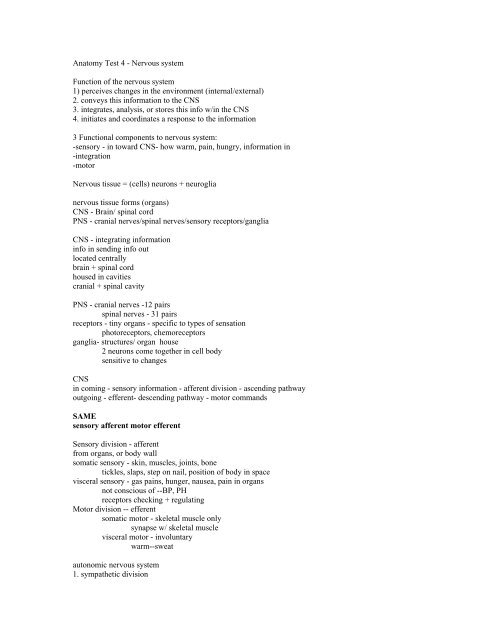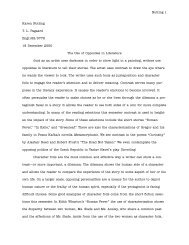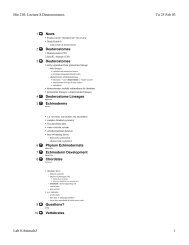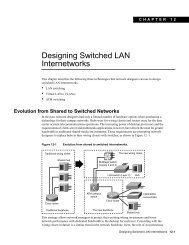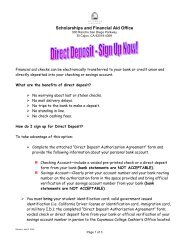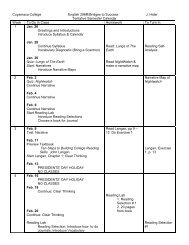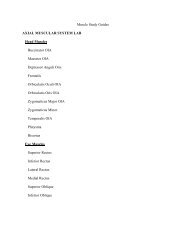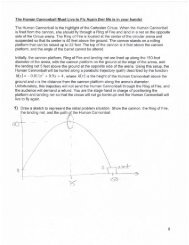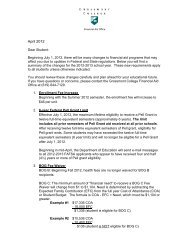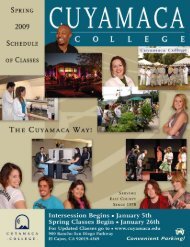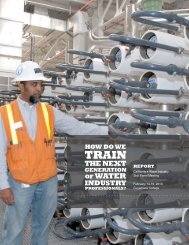Create successful ePaper yourself
Turn your PDF publications into a flip-book with our unique Google optimized e-Paper software.
<strong>Anatomy</strong> <strong>Test</strong> 4 - <strong>Nervous</strong> <strong>system</strong>Function of the nervous <strong>system</strong>1) perceives changes in the environment (internal/external)2. conveys this information to the CNS3. integrates, analysis, or stores this info w/in the CNS4. initiates and coordinates a response to the information3 Functional components to nervous <strong>system</strong>:-sensory - in toward CNS- how warm, pain, hungry, information in-integration-motor<strong>Nervous</strong> tissue = (cells) neurons + neuroglianervous tissue forms (organs)CNS - Brain/ spinal cordPNS - cranial nerves/spinal nerves/sensory receptors/gangliaCNS - integrating informationinfo in sending info outlocated centrallybrain + spinal cordhoused in cavitiescranial + spinal cavityPNS - cranial nerves -12 pairsspinal nerves - 31 pairsreceptors - tiny organs - specific to types of sensationphotoreceptors, chemoreceptorsganglia- structures/ organ house2 neurons come together in cell bodysensitive to changesCNSin coming - sensory information - afferent division - ascending pathwayoutgoing - efferent- descending pathway - motor commandsSAMEsensory afferent motor efferentSensory division - afferentfrom organs, or body wallsomatic sensory - skin, muscles, joints, bonetickles, slaps, step on nail, position of body in spacevisceral sensory - gas pains, hunger, nausea, pain in organsnot conscious of --BP, PHreceptors checking + regulatingMotor division -- efferentsomatic motor - skeletal muscle onlysynapse w/ skeletal musclevisceral motor - involuntarywarm--sweatautonomic nervous <strong>system</strong>1. sympathetic division
"fight or flight"those responses thatstressed or frightened ready to fightHR inc, blood to muscles, pupil enlargessalivary glands- stop secreting --dry mouth of speech2. parasympathetic divisionrest + digestsalivatingpupils constrictantagonist <strong>system</strong>s in generalsomatic - neurons directly to musclesautonomic - cardiac, smooth, glands, adipocytescardiac + smooth--visceral muscleeffectorsend organ- end destination of neuronneurons1. impulse transmitting cells2. high metabolic rate (great need for O2 and glucose)3. cells cannot divide (stem cells until age 4)4. transmitting "axons" found in bundles (nerves)5. extreme longevity (100 + years)6. structurea) dendrite (receptive portion of neuron)sends signal towards cell bodyb) cell body (soma)c) axons/nerve fibers (conductive process)sends signal away from bodyd) synaptic knobs (release neurotransmitterPICTUREdendritesomaaxonsynaptic knobsoutneuron neuronneuroneffectorsgrey in colorTypes of neuronsstructural difference in neurons : look differenta) multipolar neuronsmost common 99%most carry motor impulses/interneuronsb) unipolarcell body sits off to sidemost carry sensory impulses
dendrites and axon act as one "pole"c) bipolar neuronsfound in special sense organs -eyesd) anaxonic neuronsstar like (no obvious anatomical axon)located in central nervous tissue and in special sense organsNeuroglia "nerve glue" glial cells1. cannot generate impulse - but neuron can not send impulse w/out2. can divide - 75% of tumors formed by neuroglia3. supportive cells4. neuroglia of the CNSa) oligodendrocytes (CNS) - mylenating the axon- wrap aroundb) astrocytes "star like" - blood, brain barrier - make sure crosses over is safec) microglia "little eaters" - destroy debris, pathogensd) ependymal cells - line central canal of spinal cord and ventriclescerebral spinal fluid and maintain it, synthesize it, and circulate it5. neuroglia of PNSa) satellite cells - located in gangliab) schwann cell - myelinate axons - white matter(grey matter unmyelinated axons)4/7Dura Mater- most superficial - endosteum of cranium attached to bone - in certain spots splits and forms asinus--venous blood flowsArachnoid- wet saran wrap layer--spider web appearancePia Mater- outermost layer of brain in vagination - deepest layerDura Mater- attached tightly to crista galli of ethmoid bonealso divides 2 hemispheresleft + right falx cerebri **transverse fissure- tentorium cerebelli***- has a sinuscerebellum and occipital lobespinal cord- has same 3 layerspia mater towards spinal corddura mater not attached to vertebraepidural space- fat padcerebral spinal fluid - CSFproduced by capillaries + ependymal cells ---choroid plexusbring fluid in from bloodventricles- fluid w/inchoroid plexus floor of lateral ventricle, roof of 3rd, back of 4thfluid baths brain and spinal cordarachnoid granulations reabsorb the fluid - arachnoid villi absorbevery 8 hours recirculatedgranulations formed 3-4 years oldbefore that done by capillariesif not work well - **hydrocephalus- fluid not drawn backknow basic description and flow of cerebral spinal fluidcerebral aqueduct - goes to 4th ventricle
in children hydrocephalus not as serious as adultsin adults usually a tumor that blocks a duct - plates are fused and pressure buildsDEVELOPMENT OF BRAIN35 billion neurons- 98% of neural tissue in brainstart w/ dorsal hollow nerve cord then swelling of brain into 3 areas forebrain, midbrain, hind braincorpus collosum white matter allow hemispheres to communicatedevelopmental regions of the brain -encephalonspicture:forebrain enlarges to telencephalon -lateral ventricles, cerebral cortex, cerebral, hemispheres, corpuscollosumdiencephalon- has 3rd ventriclemidbrain--hind brain -mesencephalonmetenephalon - 4th ventriclemyelencephalonTELENCEHALONCerebrum - conscious thought, memory, learningfrontal lobe- primary motor cotex (conscious control of motor neurons, & higher order thought)occipital lobe- primary visual cortex (conscious awareness of visual information)parietal lobe - primary sensory cortex (conscious perception of touch, pain, temp, taste)temporal lobe - primary auditory cortex & primary (smell) olfactory cortex (conscious awarenessof sound & smell)cerebral hemispheres divided by longitudinal fissuretransverse fissure- cerebellum and cerebrumlateral fissure - separate lobesoutpockets - gyriinvagination - sulcicentral sulcus separates frontal (motor output) from parietal lobe(sensory input)frontal lobe- primary motor cortex - social appropriatenessoccipital lobe- visual cortexcerebral cortex- gray mattercell bodies + unmyelinated neuronswhite matter -myelinated neurons -fat surroundscorpus collosum - 1000s of axons cut in half in picturecommissural fibers crossover fibers from one hemispheres to otherbasal ganglia (cerebral nuclei) - contain neurons that cooperate with the cerebral cortex in controllinglarge subconscious movements (such as swinging arms while walking) involved in starting, stopping, andintensity of movements.problem w/area can't smooth movements, jerky, shaky movements, Parkinson's diseaseDIENCEPHALONThalamus- sensory "relay station" or "switchboard" for cerebral cortex; primitive awareness of sensoryinformation. It is considered the "gateway" to the cerebral cortex because ANY communication to thecerebral cortex MUST go through the thalamus where info is edited (amplified/inhibited)
dot in middleonly one pathway not go through thalamus - olfactory tract -smellhypothalamus- main control center for the autonomic nervous <strong>system</strong> (regulates HR, BP, digestivemovement, body temp, salivary and sweat glands, hunger/thirst) center of emotions (rege, fear, pleasure,and sex drive) sleep-wake cycles: endocrine controlbelow thalamusautonomic control + endocrine <strong>system</strong>can monitor the bloodMESENCEPHALONCerebral Peduncles - "little feet of the cerebrum"; contain pyramidal (corticospinal) tracts descendingfrom the cortex towards the spinal cordprimarily axonsone region of brain to specific region of spinal cordCorpora Quadrigemina - "quadruplets"; Involved in visual reflexes (tracking of our eyes on a movingobject); Involved in auditory reflexes ("startle reflex" to loud sound)METENCEPHALONPONS- bridge between cerebral cortex and cerebellum for coordination of voluntary movement;respiratory centers for regulate smooth transitions between inhalation /exhalationor bridges up from brain stem to cerebellumenlarged circle area of brain stemCerebellum- receives info about; equilibrium (inner ear), current movement of body(porprioceptors),motor commands from cerebral cortex. This allows the cerebellum to smooth and coordinate bodymovements & maintain posture/equilibrium.mini braincovered by tentorum cer?vermis- worm like structure connects to halveswhite matter- arbor vitae- tree likeinner ear, stretch receptors, position of body + motor outputs- coordination actioncerebellum used to learn to dance and to hit a ballMYELENCEPHALONMedulla oblongata- pathway for pyramidal tract, sensory relay; subconscious movement for equilibrium;visceral centers for autonomic functions (adjusts force/rate of HB, BP control, pattern/rate of breathing,reg. vomiting, hiccupping, swallowing, sneezing, coughing) Work in conjunction w/hypothalamus.respiratory senses, visceral senses, breathing,if dens breaks goes intoknow regionsexample- 1 pointer - 3 questionswhat developmental region? dicephalonwhat region of brain? thalamuswhat cavity? 3rd ventricleCranial nerves know #s and namesoff of cerebrum - olfactory nerverest off of brain stem#4 small one#5 large one#11 look like 11 off sides
start in front and move backnose, lots around eyes and then back#10-vagus- drops down to heart, lungs it’s the wandererold owls on tree tops are forever viewing green valleys and hillssome say money matters but my brother says big brains matter mosts= sensesm=motorb=both4 cranial nerves- parasympatheticknow chart - what is the sensory / motor functionknow brain chart or picture from lab bookcranial nerves can carry motor neurons only, sensory neurons only or bothdifferent than spinal nervesSPINAL CORDposition in body1. Foramen magnum L1/L2 (conus medullaris)a) spinal cord growth stops at about 4 years of ageb) vertebral column continues to grow until full height (~18 inches)cauda equina - horse tail off conus medullarisFunctions of vertebral column1. sensory/motor innervation below the neck (via spinal nerves)2. Two-way conduction between body & brain (tracts)3. Reflex center! - acts on own - some info in and respond to itProtection1. no attachment of dura mater to bone w/in spinal cavity2. epidural space filled w/ connect, tissue, fat & vessels3. cerebral spinal fluid - cushions cord4. meninges (ends at S2) dura mater, arachnoid, pia matera) dentriculate ligament- anchors cord laterallyb) filum terminale (coccygeal lig) anchors cord caudallyc) dura mater in cranial cavity- anchors cord craniallygray matter insidewhite matter outsidegray matter of spinal cord1. mostly cells bodies + interneurons unmyelinated2. "H" shape surrounding the central canal3. the "wings" of the gray matter represent the-dorsal (posterior) horn (sensory axons & interneurons)-ventral (anterior) horn (somatic- voluntary- motor cell bodies) to skeletal muscle-lateral horn- visceral motor/visceral sensoryDAVEdorsal afferent ventral efferentWhite matter of spinal cord - travel up and down1) white matter on outside of cord2. myelinated/unmyelinated axons
3. axons arrange in common "tracts" or "funiculi" / columna) funiculi (lateral/anterior/posterior)travel up, down or across one side to another2 tracings need to knowmotor tracing and sensory tractb) axons that share structural or functional similarities (ascending/descending)Dermatonesif on al 4's4 plexuses - neurons brake off nerve wrap around other nervescervicalbrachiallumbar plexus- front of legssacral- back of legs, bottom of foot, 1 feeds to top of foot****all spinal nerves carry both sensory and motorPNSmotor divisionsomatic + visceral (autonomic)autonomicsacraland cranial - parasympatheticcentral area- sympathetic4/14/03peripheral neuronneurons found traveling in a nervesomatic - 1autonomic-2 synapse in a ganglion -protect a cell bodyfind somatic neurons in every segmentautonomic found in regional sectionssympatheticblood flow to stomach stopnot salivateHR incsweatThorocolumbar T1-L2preganglionic neuron + postganglionic neuronadrenal medulla only one w/single neuron(norepenephrine, epinephrine)parasympathetic-craniosacral CN3,7,9,10 S2-S4pain helps prevent death warningpicture-most sensory info makes it to thalamusthalamus holds things in checkdoesn't bring everything to conscious leveloccipital love- flashes of light--sight
Receptors1.vary in structure and function2. if stimulus is sufficiently strong (meets AP threshold) impulse AP occurs3. receptors show some "stimulus specific" quality4. threshold varies for various stimulus(eye--light (usually/pressure]Sensory adaptationthreshold changes- at first receptors easily stimulated - then tolerance occurs and greater stimulus is needed(bath, smells,clothes) ex. thong underwear,perfume in roomgeneral receptors- touch receptors- spread thoughout bodyreceptor fields- smaller on hand, larger on backspecial sense receptors- receptors concentratedReceptor typesmechanoreceptor-detect mechanical physical changetouch, stretch- digestive organs, deep breathproprioceptors- where body position is in spacein muscles, tendons, jointswhere hand position is even not looking at itthermoreceptors- detect tempphotoreceptors- detect lightchemoreceptors-detect chemical change(taste/smell)nociceptors -(free nerve ending) detect paindendrites-sensitive to chemicals released when tissue is damagedall the receptors can act as pain receptorsTaste- gustation1. use chemoreceptorsmost found in papillaesome on palate/pharynx/larynx2. ~10,000 receptors- release through adulthood (3000)3. 4 primary taste sensationssweet-tip of tonguesour-sides of tonguebitter- back of tonguesalty- front sides of tonguefiliform papillae- flame shape- no taste buds onfungiform papillae- dispersed throughout tonguecicumvillate paillae- v-shaped in back4. work w/ smell to detect variations of taste (raspberry)if cannot smell can not taste raspberrydry tongue - not taste anythingchemoreceptors need liquid to workCranial nerves of gustation--vagus, glossopharyngeal, facial (front of tongue)Smell- olfactionlocated roof of nasal cavity1. use chemoreceptorsreceptors embedded in mucous membranefound in 1 inch patch on roof of nasal cavityolfactory2. ~10-20 million receptors (50 billion in blood hound)
3. 4 molecules of gas can cause an action potential4. sends sensory info to temporal lobe5.only one to bypass thalamusVision1. most complex2.70% of all body receptors are found in eye3. use photoreceptorscones- detect color (3 types) visual acuity(sharpness) - if color blind miss a conerods- detect light/dark4. 3 tunicsFibrous tunicsclera-"white of eye" (opaque)cornea- "window of the eye" (no blood vessels)vascular tunicchoroids- pigmented layer (absorb light)cilliary body- muscle that suspends/moves lensiris- muscular diaphragm used to adjust light (pigmented)lens-clear/flexibleblue eyes- pigment just in backbrown- pigment throughoutnervous tunic - retina****made of nervous tissuecontains of photoreceptorsfovea**- concentration of cones only at back of eye - focal point- small depressionoptic disc**- "blind spot" where optic nerve exitsback of eye- no photoreceptorslacrimal gland- lateraltearing across the eye- to medial side- drains into nasal cavityFor test know developmental area, origin, brain area, invaginationEAR3 regions of the earouter earpinna -ear flapauditory canal (lined w/ hair/wax)typmpanic membrane (skin covered)- thin membranewax- cleans ear, sloughs off debris and insecticideMiddle earauditory tube- connects ear to throatusually closed, opens w/chewing and contractioninfants is wider so milk bacteria cause ear infectionthat's why have head up when feedinghave a cold-swell up make auditory canal had to openpressure in earequalizes pressure in and out of middle earallows membrane to vibrate properlymiddle ear ossicles- only bones in skull w/synovial jointsallows more flexibilitymaleous-touches typmpanic membraneincus-middle bonestapes-looks like stirrup attached to oval window- causes vibration of oval windowif anticipating loud bang and tense muscles tighten to prevent harsh vibration
ear ossicles- bones malleus--incus--stapesauditory tube- connects ear to pharynx & adjust pressure air filledInner earbony labyrinth (canals w/in temporal bone)membraneous labyrinth (inside bone)contains cochlea (hearing)contains semicircular canals/vestibule (enlarged area)(equilibrium)Hearing1. mechanoreceptors found in chochlea2. stapes vibrates against oval window (moves fluid)3. hair cells bend as sound waves more fluid (endolymph) and membranes in cochlear ductorgan or cortiperilymph in bony partEquilibrium1. mechanoreceptors found in semicircular canals- right angles to each otherreceptors in ampullae, receptors ben(dynamic equilibrium) movement of body/head ex. spin in circles, summersaults2. mechanoreceptors found in vestibule - in saccule, utricles---little crystals(static equilibrium) position of head/gravity ex. up in an elevator, forward in car3. send info to cerebellum to interpretknow difference between 2 movementswhen basilar membrane moves, distorts hair cells, sound wavesEndocrine <strong>system</strong>Exocrine glands example- sweat glands, salivary glands-secrete product into duct (tube)-secrete directly in desired locationendocrine glands example- thyroid gland-secrete hormone into bloodstream-hormone travels through body to all cells-only cells w/ receptor affected- not effect any cell that does not have a receptor for that hormone-goes out to whole bodypancreas - endocrine + exocrine (pancreatic enzymes to sm intestine)<strong>Nervous</strong> <strong>system</strong>1. short-term effects (seconds to minutes)2. very specifically targeted (directly on effector)3. neurotransmitter at synapse4. immediate response/recoveryEndocrine1. long term effects( minutes to days)2. general response (many effectors-varied response)3. hormones into circulation4. seconds to hours response/recoveryNegative feedback
gland secrete insulinblood sugar levels riseblood sugar levels declinehomeostasis(normal blood sugar levels)Parathyroid + Ca2+ levels in bloodlow Ca levels in bloodactivatesparathyroidproducesPTHeffectkidney decreases Ca excreted in urineboneincreases osteoclast activitytherefore increase Ca blood levelsfeedback (stops action)increase in blood Ca levelscontinues until level of calcium at proper levelPositive feedback - rare - drastic effect quicklygland secrete oxytocinuterine wall stretchesuterine wall contractsexacerbates the situationex. giving birth, or bleedingOxytocin & birthFetus putting pressure on uterusactivateshypothalamus to neurohypophysisproducesoxytocineffectincreases uteran contractionsfetus places more pressure on uterus (feedback increases action)must have complete end of process--birth finally occursAct as Neuro-Endocrine GlandsHypothalamus-as an endocrine gland-produces hormones (ADH & oxytocin)- sends to pituitary-as a regulatory gland-produces "tropic" regulatory hormones to stimulate/inhibit secretion
"reads" blood-regulate autonomic centers to stimulate adrenal medulladecide if too high or too low in hormonescan direct release of hormonesthe "master gland"Pituitary gland(hypophysis):-as an endocrine gland-produces hormones (adenohypophysis) -- anterior pituitary-glandular part- developed from oral ectoderm-as a neural structurestores hormones of hypothalamus (neurohypophysis)outpocket of the brainhormones release from hereAdrenal gland-as an endocrine gland-produces hormones (both cortex and medulla)-glandular part- derived from mesoderm (developed from posterior abdominal wall)cortex-as a neural structure-acts as a post ganglionic neuron! (release epinephrine, norepinephrine)-derived from neural crest cells (develop from nearby sympathetic ganglia)medullaanterior pituitary-huge effectnumerous effectex.growth hormonetoo much before puberty - more ventricle growth --gigantismdwarfism- too little throughout lifeafter puberty- thickening the bone after growth plates setThyroid glandthyroxine (TH) increase oxygen consumption, rate of energy, utilization, and heat production, increasemetabolismhypothyroidism --feel coldTSH- produced to make thyroid bigger to produce more thyroxineReviewmeninges-protective membranes of CNSdura mater- two layersendosteal -outermeningeal-inner layersplit apart form dural sinussuperior sagital sinus runs between longitudinal fissurearachnoidarachnoid villi-absorb cerebral spinal fluid into bloodpia mater- adheres to brainspinal cord- extension off of pia materdenticulate ligaments-lateral support to spinal cordventricles -2 lateralthird ventricle
fourth ventricleCSF withinCSF goes around outside brain and spinal cordsubarachnoid spacefound w/in central canal of spinal cordchoroids plexus-where CSFependymal cellinterventricular foramen-in between ventricleslateralthirdbrainforebrain--telencephaloncerebral cortex,corpus collosum, internal capsule, lateral ventriclediencephalons3rd ventricle,thalamus, hypothalamusmidbrain mesenscephalonhind brainmetencephalonmyencephalon---4th ventricle, medulla oblongatalobes of cerebrumfrontal-motor cortexparietal -sensory cortex,tastetemporal-hearing,equilibrium, smelloccipital-visioncerebellum- 2 hemispheresvermis attaches 2fine tunes movements, equilibriumlearned movementsproprioceptors-where body in spacemedulla oblongata-visceral motor controlascending + descending tracts from spinal cordspinal cord-conus medullarisnerves- cauda equinafilum terminale- extension of pia materepidural space-superficial to dura matergray matter in core opposite of brainwhite matter- faciculus tractsdorsal horn - sensory (afferent)dorsal root ganglion- cell bodies-afferent cell bodiesventral horn- efferent cell bodiesdorsal and ventral ramus-afferent + efferentdorsal- back, neckventral- rest of the bodyplexus -network of branchescross section of nerve


